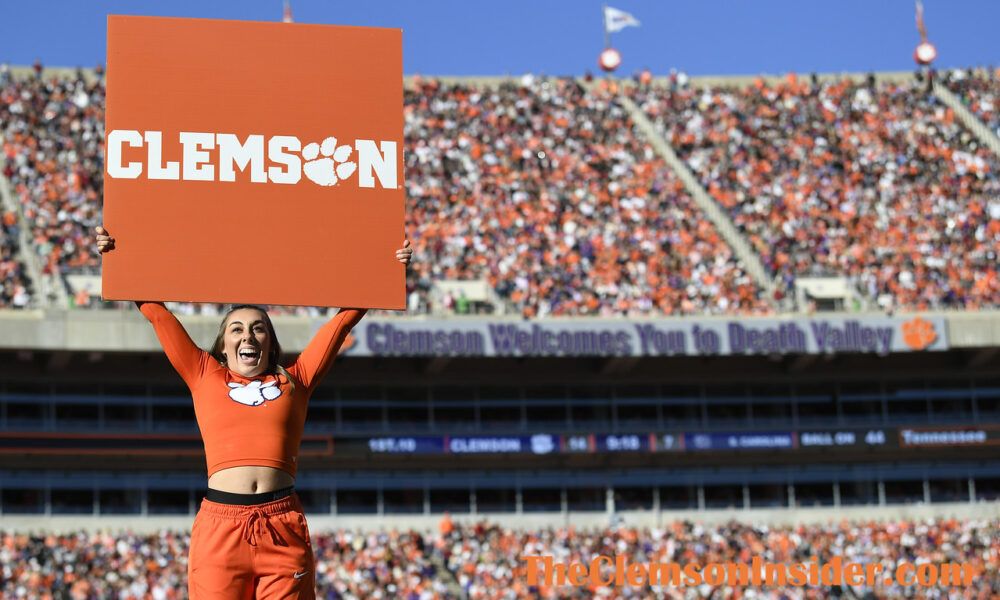CLEMSON — Cally Gault remembers his first trip to Clemson quite well. A freshman at Presbyterian at the time, he and his Blue Hose teammates came to Clemson and were thrashed, 76-0.
The Tigers netted 516 yards on the ground that afternoon, as 14 different players carried the ball on September 22, 1945. Clemson freshman Bobby Gage, who went on to play for the Pittsburgh Steelers, led the Tigers with 144 yards, including an 88-yard touchdown run.
All 11 of Clemson’s touchdowns came on the ground that afternoon, which is a record that still stands today.
Soon after being beat so bad by the Tigers, then Presbyterian head coach Lonnie McMillian started referring to Memorial Stadium in Clemson as “Death Valley.”
“After we were beaten so badly in 1945, Coach McMillian and us players referred to the Clemson trip as going ‘to Death Valley,’” an 83-year old Gault said back in 2012. “I’m not sure when the press picked up on it, but I’m sure it was real soon.”
The press picked up on it because McMillian would tell them, “I’m taking my boys to Death Valley,” when he spoke about the Clemson trip every year. Presbyterian and Clemson opened every football season from 1930-1957.
Gault was a player and coach during most of those years, and never did the PC teams he was on come close to beating Clemson, which became relevant on the national scene in the late 1930s and early 1940s.
“I was 16 years old as a freshman when I came to PC, and playing in Death Valley was special,” said Gault, who was also the head coach at Presbyterian from 1962-’84. “I do remember this more than anything – it was hot, and I mean real hot at Clemson.
“You haven’t felt hot until you played in Death Valley in early September.”
Clemson head coach Frank Howard soon picked up on the moniker “Death Valley” and started referring to Memorial Stadium as such when he went to IPTAY meetings or when speaking to the press. The earliest accounts of Howard using the nickname came in the late 1940s and early ’50s when the Tigers were making regular trips to the Orange Bowl and Gator Bowl and were a national player in college football.
“When Coach Howard picked up on the nickname and started using it to the media, it became really popular,” Gault said.
Tiger Stadium was called “Deaf Valley”
In 1957, a young athlete by the name of Billy Cannon made his way to LSU. A local kid from Baton Rouge, Cannon was one of the more sought after players in the country. He scored 39 touchdowns his senior year of high school, allowing him to earn All-American honors.
Cannon was also a track star and was clocked running 100-yards in 9.4 seconds and 4.12 seconds in the 40.
At LSU, Cannon lived up to the hype. As a three-year starter in 1957, ’58 and ’59 he set all sorts of records, while leading the Tigers to their first national championship in 1958 and winning the Heisman Trophy in 1959.
But his most memorable moment, and the one that started the controversy on who owns the rights of being called the original “Death Valley” came on Halloween night in 1959. Trailing No. 3 Ole Miss, 3-0, late in the game, Cannon had his Heisman moment when he took a punt at his own 11-yard line, broke seven tackles before he got to his own 40, and then ran away from everyone the final 60 yards for the game-winning score.
In Marty Mule’s 1993 book, called the Eye of the Tiger, One Hundred Years of LSU Football, he describes that night and at the same time speaks to the origin of how Tiger Stadium became known as “Death Valley.”
In the Chapter called “Death Valley USA,” starting on page 123, Mule wrote about the reaction from Cannon’s 89-yard punt return to beat Ole Miss.
Mule wrote: “The noise level generated by Cannon’s run is to have supposed to have brought people scurrying from their homes for miles around to see what happened, part of why Tiger Field was dubbed ‘Deaf Valley.’
The name ‘Death Valley’ – which was used first at Clemson – was picked when the original term was not properly enunciated, and misunderstood.”
In other words, LSU never intended Tiger Stadium to be called “Death Valley.” The locals could not say “Deaf Valley” correctly. Also, it proves Tiger Stadium’s nickname did not come until almost two decades after Clemson began using the moniker “Death Valley.”
Former LSU and South Carolina head coach Paul Dietzel confirmed Mule’s writings to The Clemson Insider back in 2012. Dietzel coached the LSU Tigers from 1955-’61 and said the nickname “Death Valley” was not used to describe Tiger Stadium while he was the head coach in Baton Rouge.
“I don’t think so. That came a little later,” said Dietzel at the time.
The debate on which stadium is truly college football’s Death Valley has been going on for decades, but the facts of the matter clearly show Clemson’s Death Valley was nicknamed such way before LSU even thought about nicknaming its stadium.
Also, and perhaps the most important fact to remember here. Frank Howard Field at Memorial Stadium in Clemson, South Carolina is actually in a real valley, hence the reason why the Clemson players have a hill to run down when they enter the stadium on fall Saturdays.
Tiger Stadium is located in Baton Rouge, La., and is barely above sea level.
Clemson and LSU will kick off the season at Death Valley in Clemson on Aug. 30 to open the 2025 season.
